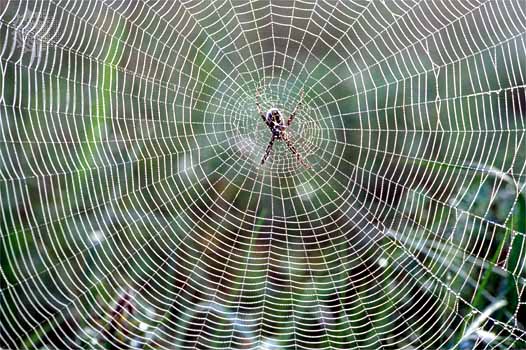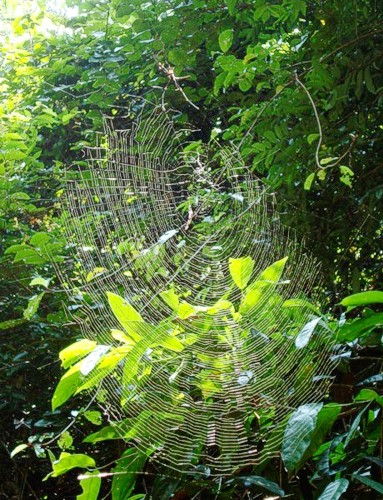Team:Newcastle/Spider silk
From 2010.igem.org
(Difference between revisions)
RachelBoyd (Talk | contribs) |
RachelBoyd (Talk | contribs) (→Background Info) |
||
| (3 intermediate revisions not shown) | |||
| Line 1: | Line 1: | ||
{{Team:Newcastle/mainbanner}} | {{Team:Newcastle/mainbanner}} | ||
| + | |||
| + | =Spider Silk= | ||
| + | |||
| + | ==Background Info== | ||
{| | {| | ||
|- | |- | ||
| - | |||
| - | |||
|'''World’s strongest spider silk''' comes from species of the genus ''Nephila'' | |'''World’s strongest spider silk''' comes from species of the genus ''Nephila'' | ||
|- | |- | ||
| Line 18: | Line 20: | ||
|http://www.naturia.per.sg/buloh/inverts/nephila.htm | |http://www.naturia.per.sg/buloh/inverts/nephila.htm | ||
|- | |- | ||
| - | |[[Image:Spider Web.jpg]][[Image:Golden orb web.jpg]] | + | |[[Image:Spider Web.jpg|300px]] [[Image:Golden orb web.jpg|300px]] |
| + | |- | ||
| + | |[[http://www.virginiacheeseman.co.uk/giant-orb-web-nephila-madagascarensis-spiderling-p-551.html?osCsid=30c2683bb246801f57f686d92432fa20| Buy a ''Nephila'']] | ||
| + | |} | ||
| + | |||
| + | ==Major Ampulate Spidroin Proteins== | ||
| + | {| | ||
|- | |- | ||
|'''Spider silk''' is comparable in strength to carbon fibres | |'''Spider silk''' is comparable in strength to carbon fibres | ||
| Line 62: | Line 70: | ||
|''B.subtilis'' potential host as simple secretion system compared to yeast. Secretion has advantages over expression in ''E.coli'' however; insufficient proportion of protein was secreted by yeast. | |''B.subtilis'' potential host as simple secretion system compared to yeast. Secretion has advantages over expression in ''E.coli'' however; insufficient proportion of protein was secreted by yeast. | ||
|- | |- | ||
| - | | '''Fahnestock, S. R., Yao, Z., & Bedzyk, L. a. (2000). Microbial production of spider silk | + | | '''Fahnestock, S. R., Yao, Z., & Bedzyk, L. a. (2000). Microbial production of spider silk pr}oteins. Journal of biotechnology, 74(2), 105-19. Retrieved from http://www.ncbi.nlm.nih.gov/pubmed/11763501.''' |
| + | |} | ||
| + | ==Self Assembly and pH== | ||
| + | {| | ||
| + | |- | ||
| + | |Self assembly of Spider silk proteins is controlled by a pH sensitive relay. | ||
| + | |- | ||
| + | |A drop to pH 6.3 and shearing forces are believes to result in the hard form of spider silk. | ||
| + | |- | ||
| + | |Miniature spidroins (a few repeats 4repCT) form metre long fibres irrespective of pH. | ||
| + | |- | ||
| + | |Introduction of N-terminal domain from MASP1 (''Euprosthenops australis'') | ||
| + | |- | ||
| + | |to mini spidroins allows self assembly at pH 6.3 and delays aggregation above pH7. | ||
| + | |- | ||
| + | |Relay- like mechanism N terminal regulates assembly. pH 8 NT-mini spidroins for long firbes over days at pH 6 they form rapidly. | ||
| + | |- | ||
| + | |C-terminal domain promotes Silk formation by ordering the repetitive segments. | ||
| + | |- | ||
| + | |'''Askarieh, G. et al., 2010. Self-assembly of spider silk proteins is controlled by a pH-sensitive relay. Nature, 465(7295), 236-238. Available at: http://www.nature.com/doifinder/10.1038/nature08962.''' | ||
| + | |} | ||
Latest revision as of 12:52, 5 July 2010

| |||||||||||||
| |||||||||||||
Contents |
Spider Silk
Background Info
| World’s strongest spider silk comes from species of the genus Nephila |
| (The golden orb spider: the largest spider in this genus is Nephila maculata) |
| Its impressive web can be up to 6metres long and 2metres wide and last several years. |
| It has long been used by man; tribal people wrapped it around sticks to catch fish. |
| In a modern setting its uses are becoming more and more valuable from parachutes to bullet proof vests and in this |
| project as measure to help fix cracks in concrete. |
| http://www.naturia.per.sg/buloh/inverts/nephila.htm |
 
|
| Buy a Nephila |
Major Ampulate Spidroin Proteins
| Spider silk is comparable in strength to carbon fibres |
| Highly structured at the nanometre scale – not good for synthetic materials |
| Repetitive structures- GXG motif |
| Glycine rich segments – hard and soft segments alternating |
| Hard= hydrogen bonding cross-linked crystallites (polyalanine) forming an amorphic beta sheet structure, |
| Soft= flexibility (Glycine rich) |
| Major protein from Nephila clavipes – MaSP1 tandem variants of |
| A GQG GYG GLG SQG A GRG GLG GQG A GA6GGx |
| MaSP2 also has a repetitive structure – difference soft segment contains proline containing pentamers: The consensus repeat is _GPGGY GPGQQ.3GPSGPGS A8. Similar structure to Elastin – elastic properties of drag-line by the folding of pentamer structure. |
| In the spider – silk in 3 phases |
| 1) Extremely viscous (withstand shear forces inside spider), |
| 2) Liquid crystallite lower viscosity (near exit duct/glycine rich may be involved), |
| 3) Insoluble fibre (result of dehydration and drawing). |
| MaSP1 and MaSP2 – Drag line |
| MaSP1-Auxilary |
| MaSP2- Glue silk only |
| Neither- Cocoon silk |
| Super contraction associated with pentamer motif when wet: low visco-elasticity |
| Mimic natural proteins or simplify – Mimic structural significance still uncertain for some sequences |
| DPB1- Optimised for B.subtilis |
| B.subtilis potential host as simple secretion system compared to yeast. Secretion has advantages over expression in E.coli however; insufficient proportion of protein was secreted by yeast. |
| Fahnestock, S. R., Yao, Z., & Bedzyk, L. a. (2000). Microbial production of spider silk pr}oteins. Journal of biotechnology, 74(2), 105-19. Retrieved from http://www.ncbi.nlm.nih.gov/pubmed/11763501. |
Self Assembly and pH
| Self assembly of Spider silk proteins is controlled by a pH sensitive relay. |
| A drop to pH 6.3 and shearing forces are believes to result in the hard form of spider silk. |
| Miniature spidroins (a few repeats 4repCT) form metre long fibres irrespective of pH. |
| Introduction of N-terminal domain from MASP1 (Euprosthenops australis) |
| to mini spidroins allows self assembly at pH 6.3 and delays aggregation above pH7. |
| Relay- like mechanism N terminal regulates assembly. pH 8 NT-mini spidroins for long firbes over days at pH 6 they form rapidly. |
| C-terminal domain promotes Silk formation by ordering the repetitive segments. |
| Askarieh, G. et al., 2010. Self-assembly of spider silk proteins is controlled by a pH-sensitive relay. Nature, 465(7295), 236-238. Available at: http://www.nature.com/doifinder/10.1038/nature08962. |
 "
"